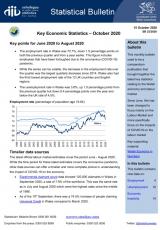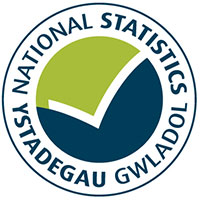Monthly data which covers topics such as employment, indices, exports and earnings.
This is not the latest release in the series: Labour market overview
Note on reweighting
On 13 October 2020, ONS reweighted the Labour Force Survey (LFS) for the periods January to March 2020 to May to July 2020.
The coronavirus (COVID-19) pandemic meant that LFS interviews moved from being mainly face to face to telephone interviews earlier in the year. This led to a change in the types of households responding to the survey, and a potentially less representative sample in terms of housing tenure. The survey has therefore been reweighted so that the housing tenure distribution is the same as before the pandemic hit in March. This is explained in detail in an Office for National Statistics blog.
While the re-weighting has not changed the general trend of the data, it has decreased the employment rate for Wales, and increased the unemployment and economic inactivity rates.
Headline labour market indicators, for the three months to August 2020
While the whole of the time period for these LFS estimates cover the coronavirus (COVID-19) pandemic, other data sources, such as the number of paid employees presented later in this headline, offer a timelier and more complete picture in understanding the impact of COVID-19 on the economy.
Employment rate
Wales: The employment rate in Wales was 72.7%. This is 1.5 percentage points down on the quarter and 1.5 percentage points down on the year.
UK: The UK employment rate was 75.6%. This is 0.3 percentage points down on the quarter and 0.3 percentage points down on the year.
Unemployment rate
Wales: The unemployment rate in Wales was 3.8%. This is 1.0 percentage points up on the quarter and 0.4 percentage points down on the year.
UK: The UK unemployment rate was 4.5%. This is 0.4 percentage points up on the quarter and 0.6 percentage points up on the year.
Economic inactivity rate
Wales: The economic inactivity rate in Wales was 24.4%. This is 0.7 percentage points up on the quarter and 1.9 percentage points up on the year.
UK: The UK economic inactivity rate was 20.8%. This is unchanged on the quarter and 0.2 percentage points down on the year.
Monthly paid employees and earnings from Pay As You Earn Real Time Information
For the first time, the Office for National Statistics and HM Revenue & Customs (HMRC) have published data for Wales on payrolled employees, mean pay, aggregate pay and single month estimates for median pay.
Paid employees
The data on the number of paid employees is the first indication of how the coronavirus (COVID-19) pandemic has affected the number of employees in Wales.
- The number of paid employees has generally increased in recent years, but has fallen during the pandemic.
- The number of paid employees decreased during the pandemic to 1.23 million in July, a decrease of 29,700 people (2.4%) compared with February 2020. However, the number of paid employees has increased slightly in August and September 2020.
- Early estimates for September 2020 indicate that the number of paid employees in Wales was 1.24 million. This was a decrease of 27,100 (2.1%) on February 2020, but.an increase of 2,600 (0.2%) compared with the lowest point in July.
Median pay
- Median pay has grown in recent years but fell slightly during March and April 2020.
- In Wales, median pay has been above pre-pandemic levels since June 2020.
- Early estimates for September 2020 indicate that median pay in Wales was £1,800. This was an increase of £22 on the previous month and an increase of £64 on February 2020.
- Compared with the same month the previous year, Wales saw an increase in monthly pay of 5.6%; the fastest growth across the 12 UK countries and regions.
Reports

Key Economic Statistics: October 2020 , file type: PDF, file size: 1 MB
Data
Datasets and interactive tools
Contact
Vanessa Allis
Telephone: 0300 025 9019
Email: economic.stats@gov.wales
Rydym yn croesawu galwadau a gohebiaeth yn Gymraeg / We welcome calls and correspondence in Welsh.

